From the Shores of the Golden Horn: Music of the Spanish Jews of Turkey (Paths of Exile, Quincentenary Series Volume I)
Bridges of Song: Music of the Spanish Jews of Morocco (Paths of Exile, Quincentenary Series Volume II)
Balkan Vistas, Spanish Dreams: Music of the Spanish Jews of Bulgaria and Yugoslavia (Paths of Exile, Quincentenary Series Volume III)
Under Aegean Moons: Music of the Spanish Jews of Rhodes and Salonika (Paths of Exile, Quincentenary Series Volume IV)
Full Circle: Music of the Spanish Jews of Jerusalem (Paths of Exile, Quincentenary Series Volume V) (Titanic, 1997)
Circle of Fire: A Hanukah Concert (Songs of the Sephardim, Volume V)
The Sword of the Dove: A Judeo-Spanish Purim Fantasia (Holiday Traditions Series II)
A Different Night: A Passover Musical Anthology (Holiday Traditions Series I)
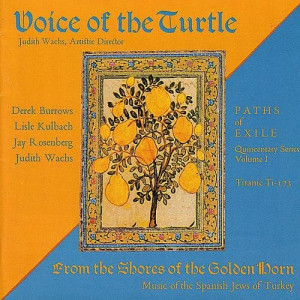 On the same day in 1492, two major events occurred in Spain. One was that Columbus was scheduled to set sail on the voyage in which he would discover America. The other was that the Jews of Spain were ordered by King Ferdinand and Queen Isabella to either convert or leave the nation. Amazingly, that day was Tisha B’Av (The Ninth of Av) on the Jewish calendar, the day that commemorates the destruction of the First Temple by the Babylonians and the Second Temple by the Romans, both of which occurred on that date.
On the same day in 1492, two major events occurred in Spain. One was that Columbus was scheduled to set sail on the voyage in which he would discover America. The other was that the Jews of Spain were ordered by King Ferdinand and Queen Isabella to either convert or leave the nation. Amazingly, that day was Tisha B’Av (The Ninth of Av) on the Jewish calendar, the day that commemorates the destruction of the First Temple by the Babylonians and the Second Temple by the Romans, both of which occurred on that date.
In this second Diaspora, the Spanish Jews were scattered. Most, though not all, of them ended up in other Mediterranean countries. These Jews are known as Sephardim from the Hebrew word for Spain. The term has since come to refer to almost all the Jews of Mediterranean or Middle Eastern origin. Those Jews who are of Northern and Central European origin are called Ashkenazim. The language of the Sephardim of Spain was Judeo-Spanish, also known as Ladino. Primarily Spanish with some Hebrew words and written in Hebrew letters, Ladino bears an analogous relationship to Spanish as Yiddish does to German.
Derek Burrows, Lisle Kulbach, Jay Rosenberg, and Judith Wachs, have been performing Sephardic music as Voice of the Turtle since 1977. All four sing as well as play a wide variety of instruments, ranging from those familiar to Western ears to those of more Middle Eastern or medieval origin. Indeed, the range of instruments that each play make it impossible to even classify any as specialists in any one type of instrument.
Much like Yiddish, Judeo-Spanish has survived to the present day, and many of the songs Voice of the Turtle performs have been learned from 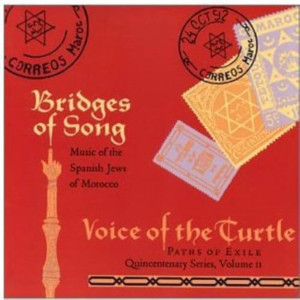 singers who sing in that language. There are a few individual phrases and an occasional song in another language, such as Hebrew. The tunes have additional influences, reflecting the traditions of Spain and the places where the Sephardim have settled, as well as having some influence from Jewish liturgical music.
singers who sing in that language. There are a few individual phrases and an occasional song in another language, such as Hebrew. The tunes have additional influences, reflecting the traditions of Spain and the places where the Sephardim have settled, as well as having some influence from Jewish liturgical music.
Voice of the Turtle’s first four recordings, The Time of Singing is Come (1978), A Coat of Many Colors (1981), Small Miracles (1983), and The Flowers Appear on the Earth (1985), were released only on cassette and at this writing are out of print. However, the remaining eight recordings are available on CD.
The heart of what is presently available by Voice of the Turtle is their Paths of Exile, Quincentenary Series. These are five recordings that were released between 1989 and 1997, in conjunction of the 500th anniversary of the exile from Spain. Each of the five CDs are devoted the Spanish Jews who have settled in various locales: Turkey, Morocco, Bulgaria and Yugoslavia, Rhodes and Salonika (Greece), and Jerusalem.
(Note: While the liner notes provide lyrics, along with the translations of the lyrics, they do not provide translations of the song titles. While I don’t know Spanish or Judeo-Spanish, I can usually deduce the titles’ translation from the lyrics, as in most cases the titles are the first or part of the first line. I hope that I have avoided mistakes in these translations, but I cannot guarantee it.)
When the Sephardim fled Spain, one of the most enthusiastic welcomes they received was from the Ottoman Empire. The Ottoman rulers of the time were amazed that another nation would throw out people with such strong technical and scientific knowledge and eagerly welcomed the Jews. From The Shores of the Golden Horn: Music of the Spanish Jews of 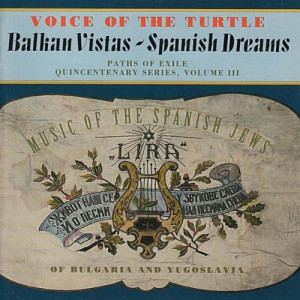 Turkey was the first released and is a good introduction to Voice of the Turtle and their music.
Turkey was the first released and is a good introduction to Voice of the Turtle and their music.
A wide variety of types of song and material are covered including humorous songs, love songs, ballads (romances), and religious songs. One of the more striking songs on this album is “O madre mia” (“O my mother”), a dirge for an elder brother, who has died serving in the Turkish wars with Bulgaria — although interestingly, the song puts the most blame on King Ferdinand of Spain for exiling the Jews. The arrangement is excellent, with an ever-present military-style drumming in the background, as the music soars to a peak with Burrows’s solid singing, backs off, then rises again.
On a much more upbeat note, “Yo hanino, tu hanina” (“I am handsome, you are lovely”) is a beautiful love song, often sung at weddings, that celebrates the impending marriage and family. In contrast, “De edad de kinzay anyoz” (“From the age of fifteen”) has a young woman celebrating her love for a “thief and a scoundrel.” She also prays that he avoids the police and eventually finds a legitimate job to earn his living. The music of these two songs also contrast; the first has a strong Middle Eastern feel, while the latter sounds more Spanish.
It used to be custom that Sephardic children would go from house to house to get the ingredients for a Hanukah feast. “Azeremoz una merenda” (“Let us make a party”) is a song about that custom. “Si savesh la buena djente,” which would be better named, “El pleto de zerzavant” — “The Battle of the Vegetables” — as it consists of an argument between the tomato and eggplant as to which is the superior vegetable. Kulbach sounds like she is 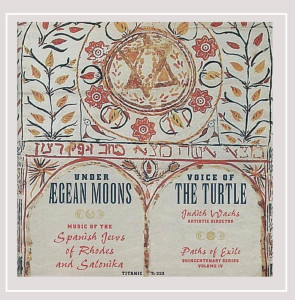 having fun singing it. (Personally, both lose as I don’t like either one of them, but that’s not an opinion universally held in the Lipsig household.)
having fun singing it. (Personally, both lose as I don’t like either one of them, but that’s not an opinion universally held in the Lipsig household.)
As someone more familiar with the Celtic, English, and American musical traditions, it’s interesting to see what similarities there are in subject matter. “Adio Rashel Levi” (“Goodbye, Rashel Levi”) consists of letters between a soldier and the pregnant sweetheart he has left behind. “Maldicha tripa de madre” (“Cursed belly of mother”) is a fragment of a romance similar to the “Mulan” tale Disney recently adapted, with the daughter of a father with no sons, disguising herself as a man to keep her father from being conscripted. There’s an interesting detail in “Maz arriva” (“Once it happened”) in that the body of a drowned prince wears a “Kamiza de Holanda,” literally, a “shirt from Holland.” The fine linen of Holland was widely enough known that it shows up in a number of English and Scottish ballads as well, including some versions of “Scarborough Fair.”
The Moroccan Judeo-Spanish communities, just across the Strait of Gibraltar, were less isolated from Spain than many other Judeo-Spanish communities. Indeed, some of the songs on Bridges of Song: Music of the Spanish Jews in Morocco did not leave Spain with the Jews, but were learned after the exile, as Spain and Morocco continued to interact with each other.
One of the most impressive performances in all of Voice of the Turtles’ recordings is “Mose salio de Misrayim” (“Moses went out of Egypt”), a ballad of Moses leaving Egypt, marrying his wife and hearing the Lord’s voice (though without mentioning the burning bush). The arrangement, starting on a psaltery (a plucked, stringed instrument that sounds somewhat like a harp), builds as other instruments are added. Wachs’ singing is perfect, matching the arrangement. The last lines include a bit of 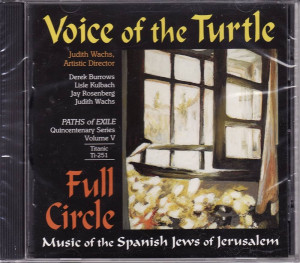 Hebrew prayer at the end. This feels like a mixture of Spanish and Middle Eastern influence without really belonging to either. The whole effect is fantastically spiritual.
Hebrew prayer at the end. This feels like a mixture of Spanish and Middle Eastern influence without really belonging to either. The whole effect is fantastically spiritual.
There are a fair number of ballads in this collection, some of which demonstrate that many songs were traded from the Jewish and Christian communities in Spain, before the exile. “Una tarde de verano” (“One afternoon in summer”) is the tale of a knight who rescues a slave from the Moors, intending to marry her, until he realizes she’s his sister. An almost identical version of the song is still sung in Spain. “Estando padre cura” (“One there was a priest”) is a humorous song about a priest’s servant who claims that she is pregnant after being “bitten by a frog!”
“Un capitan sevillano” (“A Captain from Seville”) is another version of “Maldicha tripa de madre” from the Turkish tape. This version, is more complete with the warrior maiden triumphing as a leader of soldiers, before eventually being revealed and marrying one of her fellows. This song is marked by Kulbach’s fine singing and Rosenberg’s cornetto playing. The final track is a “Wedding Suite” of seven songs, run off in quick succession with ongoing percussion, connecting the songs. It’s a very enthusiastic performance that ends this superior album on a solid note.
I found Balkan Vistas, Spanish Dreams: Music of the Spanish Jews of Bulgaria and Yugoslavia to be somewhat weak compared to the rest in this series. Maybe it’s just that it follows Bridges of Song. Maybe there’s just not that much material available; much of the Yugoslav Jewish community was destroyed in the Holocaust. The Bulgarian government protected and preserved their Jewish community during World War Two, only to have most of them flee the Communist regime. For whatever reason, this album did not come off as well as the others in the series.
Not that it’s without interest. “Pregoneroz” (“Criers”) is another variation 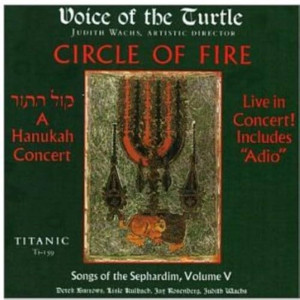 on the warrior maiden theme, but set to a tune usually used for religious songs. “Andarletto” is a fragment of a song about a queen’s unfaithfulness and her mistaking of the king for her lover. This is a lovely performance with Wachs’ singing one incredible performance, enhancing Kulbach’s performance on a bowed saz, a Middle Eastern instrument that resembles a lute.
on the warrior maiden theme, but set to a tune usually used for religious songs. “Andarletto” is a fragment of a song about a queen’s unfaithfulness and her mistaking of the king for her lover. This is a lovely performance with Wachs’ singing one incredible performance, enhancing Kulbach’s performance on a bowed saz, a Middle Eastern instrument that resembles a lute.
Voice of the Turtle has fun with a couple of children’s songs on this album. “Chichi bunichi,” a counting song, is performed a cappella and, perhaps somewhat untraditionally, since the second go-round through the songs sounds almost doo-wop. “Si veriash a la rana” (“If you could only see the frog”) is a bit of fun nonsense about animals as chefs. It’s also notable for having a Turkish chorus to the Ladino song.
But too many of the songs on Balkan Vistas, Spanish Dreams just don’t make it. “La dolor de la prensesa” (“The pain of the princess”) with a potential lover offering a woman a way out of a loveless marriage comes off as cloying. “Aman dermandjik” (“Please miller” in Turkish) is a song of flirtations, but the performance of it has little energy or eroticism.
There have long been Jews in Greece. But the influx to Rhodes and Salonika from the Spanish exile was so large that the Judeo-Spanish language and customs became the standard for the Jews of those communities, from which the music of Under Aegean Moons: Music of the Spanish Jews of Rhodes and Salonika are taken. The Jews of Salonika have had a particularly complex history. Their population was at first decreased as a result of the false messiah, Shabbatai Zevi and his subsequent forced conversion (at least, outward conversion) to Islam. Even so, Jews comprised the majority of the population in Salonika until a fire in 1917 destroyed the Jewish quarter, leaving 50,000 of its 60,000 residents homeless.
This conflagration and the subsequent time in a British-run refugee camp are hauntingly recounted in “Dia de Shaba” (“The day of the Sabbath”). The instrumental first half of the track is in itself remarkable, building from a solo ney (a simple reed pipe) and adding in several stringed instruments, before Kulbach’s vocals. The effect is like that of a fire starting up and spreading out of control.
There’s a bunch of blow-away performances on this album. “Yaakov le 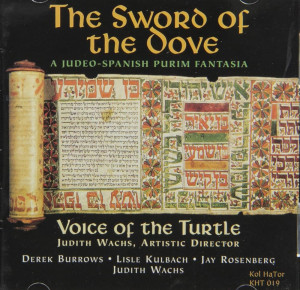 disho a Yosef” (“Jacob said to Joseph”) is a fragment of the Biblical story of Joseph with fine singing from Wachs and accompaniment from Burrows on the North African primitive harp (that’s what it says). The effect is one of the more alien, feeling neither Western European nor Middle Eastern. But it’s a very pleasant alienness. “Alta alta va la luna” (“High, high the moon”) is a sort of Sephardic song of the hours that was apparently sung after Passover Seders. Burrows’ singing is excellent here. “El rey ke muncho madruga” is a complete version of “Andarletto” that is on Balkan Vistas, Spanish Dreams. Where the version on the Bulgarian-Yugoslav album was slow and melancholy, this one is sung quickly and merrily.
disho a Yosef” (“Jacob said to Joseph”) is a fragment of the Biblical story of Joseph with fine singing from Wachs and accompaniment from Burrows on the North African primitive harp (that’s what it says). The effect is one of the more alien, feeling neither Western European nor Middle Eastern. But it’s a very pleasant alienness. “Alta alta va la luna” (“High, high the moon”) is a sort of Sephardic song of the hours that was apparently sung after Passover Seders. Burrows’ singing is excellent here. “El rey ke muncho madruga” is a complete version of “Andarletto” that is on Balkan Vistas, Spanish Dreams. Where the version on the Bulgarian-Yugoslav album was slow and melancholy, this one is sung quickly and merrily.
At the time of the expulsion from Spain, what is now Israel was controlled by the Ottoman Empire. Not only did the ruler, Bayazid, welcome the Jews to Turkey, he likewise welcomed them to Jerusalem and the Holy Land. There had always been Jews who remained there, and there had been a fairly constant number of Jews who made Aliyah and returned to Jerusalem. But when the expulsion occurred, the Jewish population of Jerusalem doubled virtually overnight.
Full Circle: Music of the Spanish Jews of Jerusalem is the final release in the Paths of Exile series. There is one thing I dislike about this recording compared to the other in the series. The first four include a bit of history of the songs in the liner notes. The liner notes of Full Circle include the lyrics and translation, but there is no additional information about most of the songs. Ah, well. Outside of that flaw, this is a decent collection, so we muddle through.
“A la gerra me vo ir” (“I go off to war”), the lament of a soldier going to war, features a dramatic singing performance by Rosenberg, as well as a lovely nay solo. “Yo era un leoniko” (“I was a young lion”) features Burrows in a moving song of a young man on the gallows. The arrangement by Voice of the Turtle has a bit of a modern feel, for all the tune feels traditional. This song would be as comfortable in a Spanish as an Israeli setting.
“Delgadina” is a widely-known song in the Spanish-speaking world, about a young woman who is locked away without water for refusing her father’s incestuous advances. Kulbach’s sings this a cappella, starting out with mournful keen, before performing an well-modulated emotional singing of the lyrics. “Madres amargadas” (“Embittered mothers”) is probably the most modern song in the collection, being written in 1960 and set to an Israeli tune dating from the 1948 War of Independence. The tune attempts to give comfort to the mothers of soldiers who died in the creation of Israel. All in all, the performances in Full Circle are solid. However, the material just didn’t seem as interesting as the previous albums.
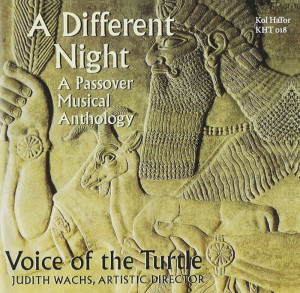 The remaining three available CDs by Voice of the Turtle are holiday-related. Circle of Fire: A Hanukah Concert was recorded before The Quincentenary Series and is Volume V of Songs of the Sephardim, the first four of which are not currently available on CD. It is a recording of a concert that was performed live on radio on December 27, 1986.
The remaining three available CDs by Voice of the Turtle are holiday-related. Circle of Fire: A Hanukah Concert was recorded before The Quincentenary Series and is Volume V of Songs of the Sephardim, the first four of which are not currently available on CD. It is a recording of a concert that was performed live on radio on December 27, 1986.
Perhaps it was the live performance or recording equipment, but Circle of Fire feels flat and lacks spirit compared to the other CDs. The leadoff track “Ocho kandelikas” (“Eight Candles”) should be a fun and rousing song, but it’s bland. Kulbach and Wachs’s voices seem especially dull, compared to the richness they produce on the other recordings. They also sound like they flubbed the ending. Another major disappointment is “Benedicyon,” one of the Hanukah prayers. The instrumental solo that makes up the first two-thirds of the track are wandering and discordant and Burrows and Rosenberg’s singing of the prayer is emotionless.
There are nevertheless some good and interesting tracks on Circle of Fire. Rosenberg’s singing of “Mi Ze Yemalel” (“Who will tell”), a Hebrew song, has the warmth and emotion missing in “Benedicyon.” “Mizmor shir hanukat habayit” (“A Psalm at the Dedication of the House”) is an energetic, upbeat version of Psalm 30. The instrumentation features Spanish medieval bagpipes that give that summon up a feeling of Ancient Israel.
There are some interesting secular songs on this album as well. “Gantis i kravata blanka” (“Gloves and white tie”) compares a stylish young man with the good-for-nothing fellow next door. There’s an extraneous, spoken introduction (in English), but it’s mostly harmless. “Mama, mirame las gambas” (“Mama, look at my legs”) has a similarly unnecessary lead-in, before getting into the relatively modern song of a young woman complaining about how her legs hurt after having danced the Charleston. Apparently the Charleston made it at least as far as Turkey. The group has a lot of fun with this piece with men singing a very funny falsetto at one point.
Still, the fun songs are not enough. Circle of Fire isn’t a bad album, but except for the incredible “Mizmor shir hanukat habayit,” it doesn’t hold a candle to the rest of the collection.
The latest series Voice of the Turtle has been working on is the Holiday Traditions Series. The Sword of the Dove: A Judeo-Spanish Purim Fantasia is actually volume II of the series. But as Purim, the celebration of Esther and Mordecai’s triumph over Haman, comes before Passover (the subject of the first volume) in the Jewish calendar, I felt more comfortable reviewing it first.
Even more than Hanukah, Purim is a spirited holiday, literally so, as one religious tradition is to get so drunk that one “cannot tell the difference between praising Mordecai and cursing Haman.” The Sword of the Dove more than lives up to that spirit. “Alevanta Mordekhai” (“Get up, Mordecai”) has a strong Middle Eastern influence, telling of Mordecai being prepared to be treated as royalty for having saved King Akhashverosh’s life. When started, I thought I’d put on Boiled in Lead’s Songs from the Gypsy by mistake. “Empesar kero kontar” (“I wish to begin to tell”) has a solid beat well suited for “dancing and leaping,” as it tells the beginning of the Purim story, recounting the power of King Akhashverosh. The Sword of the Dove features of pair of instrumentals called “Azkir” (“I will remember. Both are good, but the first one (track 5), featuring bagpipe and flute among other instruments, is remarkable.
For all the fun and celebration, it’s two of the more serious songs that are the strongest. “Ven aki Zeresh la loka” (“Come here, Zeresh, you crazy one”) is a haunting song, featuring Rosenberg’s singing. The first stanza says in part, “It’s not your turn to speak/ For you I ordered the gallows/ To be first used on Purim.” If there is one fault with The Sword of the Dove, it is that the descriptions of the songs are lacking (as in Full Circle). The result is that I’m not always sure what’s going on in the songs. If this song is of Haman lamenting that the gallows he built to hang Mordecai would be turned on him and his family, then it gives Haman a human dimension often lacking in the Purim celebration. The final track on the CD, “Kuma Elohim” (“Arise God”) is a powerful prayer for defense against troubles. This starts slow and quiet, building to an incredibly powerful ending — a perfect finish for the album.
A Different Night: A Passover Musical Anthology has one particularly good performance: Wachs’s singing of “Mose Salyo de Misrayim” (“Moses went out of Egypt”). However, she also sang this song on Bridges of Song: Music of the Spanish Jews in Morocco and did a better version the first time around. “Ah Moshe” (“Ah Moses”) is a pleasant, slow song of God ordering Moses to return to Egypt. Burrows plays guitar with a really good, renaissance-like touch. “Adair Hu” (“Mighty is God”) is a nice quick version of the classic Passover prayer that is quite different from the slower version I was raised with.
However, there is one big problem with A Different Night. Now, I know “Chad Gadya” (“One Kid”) is a popular Passover song that is widespread with many different versions. But devoting twelve of the twenty tracks to it, including a fourteen-minute long suite of twelve different versions as the last track is just overkill of that poor little goat, especially given the range of prayers and songs that are part of the Passover celebration. I’ve no doubt there are some good versions in there, but they all blend into goat-mush. Thankfully, Voice of the Turtle released A Different Night before The Sword of the Dove, so they are definitely not going downhill with the Holiday Traditions Series.
At this writing Voice of the Turtle has been around for over twenty years with the same lineup. How many groups can that be said of? Their output has been solid to spectacular with Bridges of Song, Under Aegean Moons, and The Sword of the Dove shine above the rest. But with the exception of A Different Night all are good examples of Judeo-Spanish music.
I dedicate this review to my wife, Patti. Patti proofreads and makes suggestions on all my reviews before they go to the editors of Green Man Review. I always appreciate her help, so she deserves a dedication, anyway. But she went above and beyond in her work on this review. Thank you, Patti.
(Titanic, 1989)
(Titanic, 1990)
(Titanic, 1991)
(Titanic, 1994)
(Titanic, 1987)
(Kol HaTor, 1997)
(Kol HaTor, 1996)
[Update: It appears that most or all of these titles are available as CDs online, and many of them are on streaming services.]
